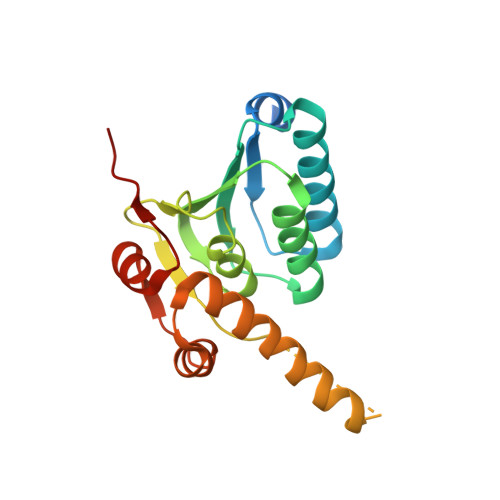Reversible inhibition of the ClpP protease via an N-terminal conformational switch.
Vahidi, S., Ripstein, Z.A., Bonomi, M., Yuwen, T., Mabanglo, M.F., Juravsky, J.B., Rizzolo, K., Velyvis, A., Houry, W.A., Vendruscolo, M., Rubinstein, J.L., Kay, L.E.(2018) Proc Natl Acad Sci U S A 115: E6447-E6456
- PubMed: 29941580
- DOI: https://doi.org/10.1073/pnas.1805125115
- Primary Citation of Related Structures:
6DKF - PubMed Abstract:
Protein homeostasis is critically important for cell viability. Key to this process is the refolding of misfolded or aggregated proteins by molecular chaperones or, alternatively, their degradation by proteases. In most prokaryotes and in chloroplasts and mitochondria, protein degradation is performed by the caseinolytic protease ClpP, a tetradecamer barrel-like proteolytic complex. Dysregulating ClpP function has shown promise in fighting antibiotic resistance and as a potential therapy for acute myeloid leukemia. Here we use methyl-transverse relaxation-optimized spectroscopy (TROSY)-based NMR, cryo-EM, biochemical assays, and molecular dynamics simulations to characterize the structural dynamics of ClpP from Staphylococcus aureus (SaClpP) in wild-type and mutant forms in an effort to discover conformational hotspots that regulate its function. Wild-type SaClpP was found exclusively in the active extended form, with the N-terminal domains of its component protomers in predominantly β-hairpin conformations that are less well-defined than other regions of the protein. A hydrophobic site was identified that, upon mutation, leads to unfolding of the N-terminal domains, loss of SaClpP activity, and formation of a previously unobserved split-ring conformation with a pair of 20-Å-wide pores in the side of the complex. The extended form of the structure and partial activity can be restored via binding of ADEP small-molecule activators. The observed structural plasticity of the N-terminal gates is shown to be a conserved feature through studies of Escherichia coli and Neisseria meningitidis ClpP, suggesting a potential avenue for the development of molecules to allosterically modulate the function of ClpP.
Organizational Affiliation:
Department of Molecular Genetics, University of Toronto, Toronto, ON M5S 1A8, Canada.














